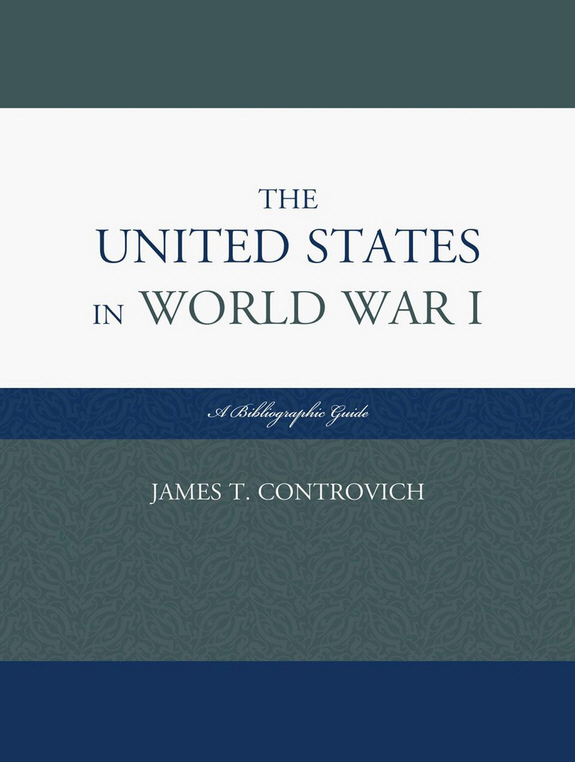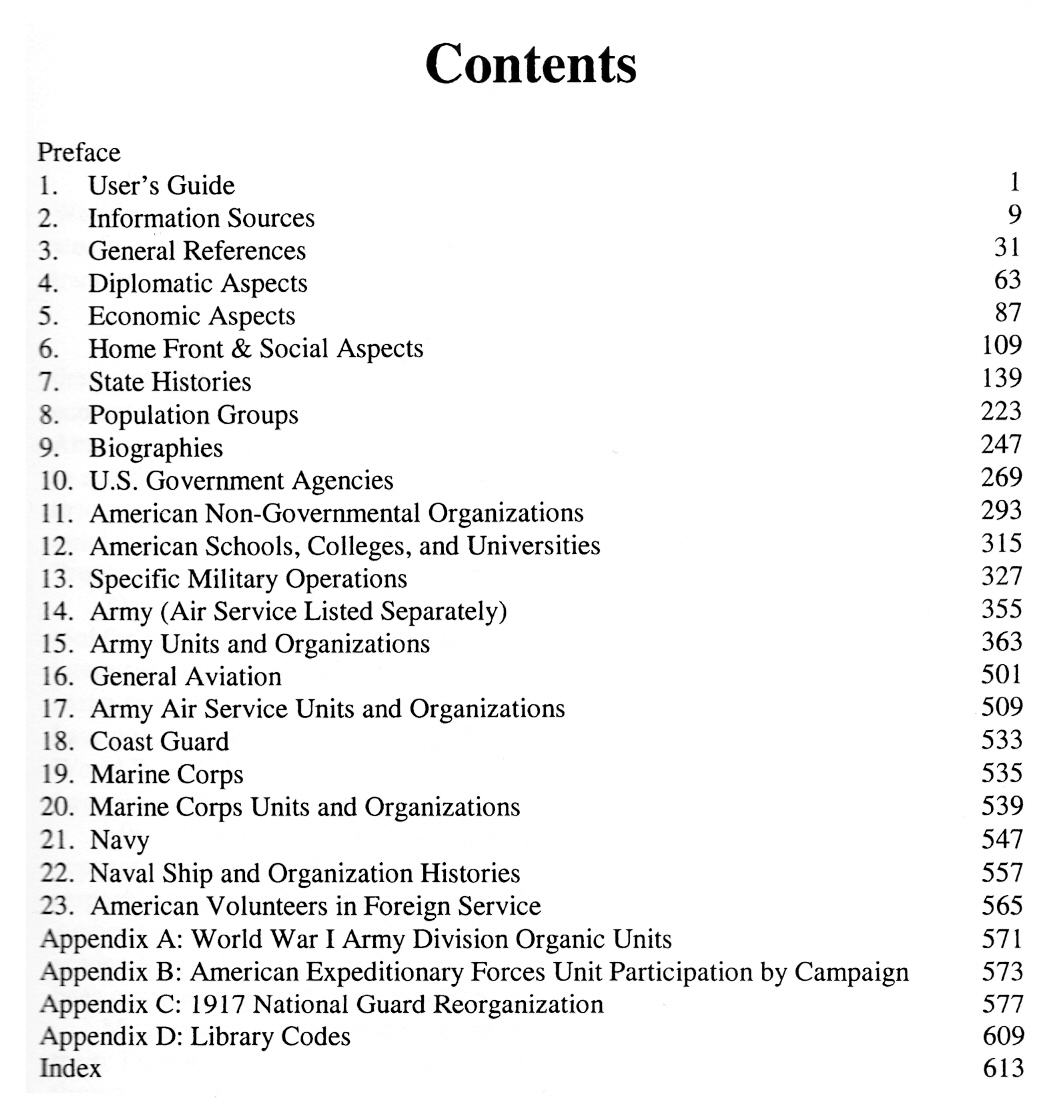
July 2014 |
 |
|


The Centennial Has Arrived
The final editing for the July issue of the Trip-Wire is just wrapping up on Saturday 28 June 2014, the anniversary of the events in Sarajevo. Early reports are of a festive atmosphere in the city of the assassination.
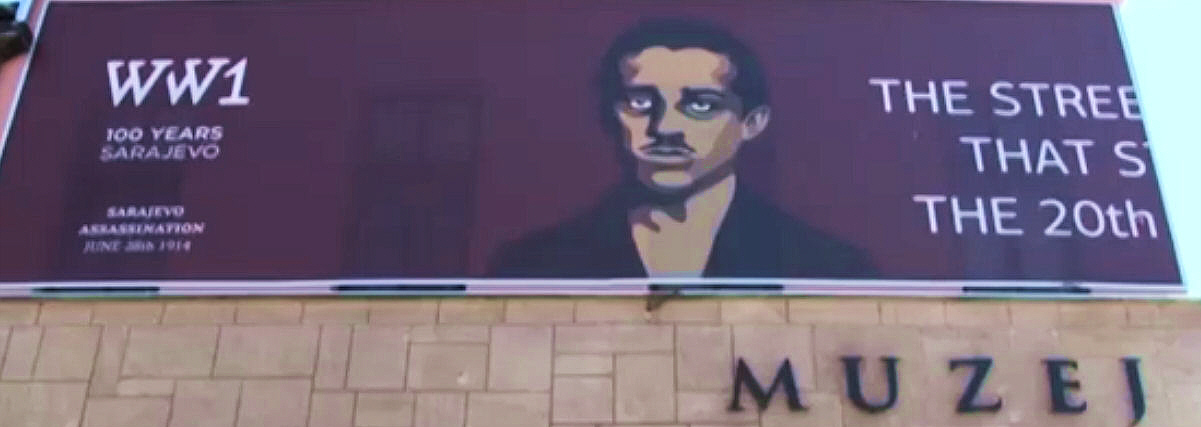
Poster Overlooking the Sarajevo Assassination Site
Here in the States there is much to be found online in various computer-friendly formats as streaming video, YouTube, and slide shows, mostly from European sources, although the New York Times and Atlantic magazine are producing some excellent material. However, the absence of live television coverage (at least as of midday) means most of the American public will remain oblivious of the importance of today's anniversary. For months I've been looking forward to the broadcast of the concert in Sarajevo by the Vienna Philharmonic that was to feature a mixture of suitable classics with compositions by veterans of the Great War like Maurice Ravel and Alban Berg. I remember Leonard Bernstein conducting Beethoven's Ninth Symphony in Berlin on Christmas Day 1989 to mark the fall of the Berlin Wall and was looking forward to something equally moving and evocative today. However, American audiences won't be hearing it today.
Nonetheless, efforts to commemorate the Centennial are gearing up here in the U.S. On Page Two below, we have begun a series of reports following up on the National Centennial Commission's first (and in my view highly successful) effort to bring together the organizations and individuals who are going to roll up our sleeves to make sure the American experience and sacrifice in 1914-1918 is remembered and appreciated. I hope that as we present information on this variety of commemorative projects that each of you find one that you can support in some way. MH

|
2014
 West Point Announces First World War Conference: "Literature, Memory, and the First World War," 11-14 September 2014 Details, Registration, and Call for Papers. West Point Announces First World War Conference: "Literature, Memory, and the First World War," 11-14 September 2014 Details, Registration, and Call for Papers.
 Oshkosh 2014, 28 July - 3 August, Will Feature WWI Replica Aircraft from Canada's Great War Flying Museum Including: a Sopwith 1-1/2 Strutter, Royal Aircraft Factory S.E.5a, Nieuport 28, and Fokker Dr.I Visit Website. Oshkosh 2014, 28 July - 3 August, Will Feature WWI Replica Aircraft from Canada's Great War Flying Museum Including: a Sopwith 1-1/2 Strutter, Royal Aircraft Factory S.E.5a, Nieuport 28, and Fokker Dr.I Visit Website.
 The MacArthur Memorial and Museum in Norfolk, VA: (1) Exhibit — "The 42nd 'Rainbow' Division in World War One," through September 2014; (2) Symposium — 14-15 November 2014, 10:00 a.m.-5:00 p.m., "World War I Centennial;" Free and open to the public. Program and Online Registration now available at: Website. The MacArthur Memorial and Museum in Norfolk, VA: (1) Exhibit — "The 42nd 'Rainbow' Division in World War One," through September 2014; (2) Symposium — 14-15 November 2014, 10:00 a.m.-5:00 p.m., "World War I Centennial;" Free and open to the public. Program and Online Registration now available at: Website.
 "Autumn Wings" and "Dawn Patrol Rendezvous" — the League of WWI Aviation Historians and the U.S. Air Force National Museum at Wright-Patterson AFB, OH, are collaborating on a double flying event for the WWI centennial. The League's Seminar is scheduled to precede the WWI Dawn Patrol Fly-In at the Museum in Dayton, OH, 24-28 September 2014.
Information on both events "Autumn Wings" and "Dawn Patrol Rendezvous" — the League of WWI Aviation Historians and the U.S. Air Force National Museum at Wright-Patterson AFB, OH, are collaborating on a double flying event for the WWI centennial. The League's Seminar is scheduled to precede the WWI Dawn Patrol Fly-In at the Museum in Dayton, OH, 24-28 September 2014.
Information on both events
|
|
Centennial Headline of the month

Headline of 26 July 1914: The Austro-Hungarian government had issued its ultimatum to Serbia on 23 July and subsequently found the response unacceptable. Emperor Franz Josef signed the mobilization order on the evening of 25 July.

Explosion!: The Barrage of New WW1 Photo Collections
More individuals and organizations are checking their attics and archives. Some remarkable series of photo sets are being made available online.
 Private French Collection
Private French Collection
 Editors' Selections from Atlantic magazine. (10-part series)
Editors' Selections from Atlantic magazine. (10-part series)
 Present-day Antwerp Fades into 1914 (Video Format)
Present-day Antwerp Fades into 1914 (Video Format)
 Private German Collection
Private German Collection
 British Women at War
British Women at War
 Selections from the French Ministry of Defense
Selections from the French Ministry of Defense
 Imperial War Museum Access to Ministry of Information Collection
Imperial War Museum Access to Ministry of Information Collection
 Snoopy & the Red Baron from the National WWI Museum
Snoopy & the Red Baron from the National WWI Museum

A Forgotten Figure of the Great War
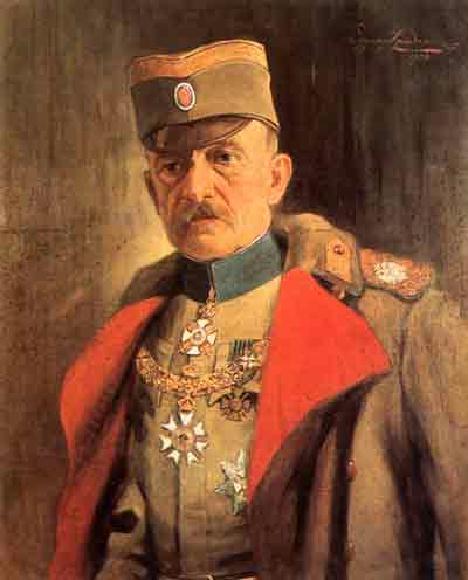
General Zivojin Misic was Serbia's greatest military commander of the First World War. Called from retirement, he led the Serbian forces in defeating the two initial Austrian invasions of his homeland. An opponent of the great retreat across the Albanian mountains to Corfu, he nonetheless accompanied the troops. He later resumed command of the Serbian forces on the Salonika Front that helped decisively defeat Bulgaria and opened back doors into both Austria-Hungary and Turkey.

Le Hamel — 4 July 1918
From midnight until daylight it was one grand roar, the sky was as red as fire continuously, and there were men, horses, and wagons, motorcycles and trucks rushing here and there like mad, and last but by no means least the Red Cross ambulances. The only way that I can express it is to say that it was Hell, just plain hell and then some. Just imagine big guns firing so fast for three hours that it sounds just like one long roar, and then think of thousands of small guns, rifles and hand grenades added to it and you will know a little about our Fourth of July celebration. I know now what it is to have your ear drums go in and out like a lace curtain at the window on a windy day.
Sgt. Wallace McCornack, 108th Engineers, 33rd Div., AEF
(Thanks to the WW1 Research Institute)
|

|

U.S. Centennial Organizations & Resources
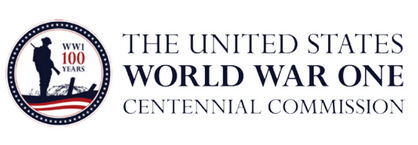
worldwar-1centennial.org/
|
The Centennial Commemorations Are Beginning Overseas
Over 70 countries that were involved in the first World War will participate in Frances Bastille Day parade on 14 July. Three soldiers from each guest country will march down the Champs-Élysées, followed by four young persons from the same countries. The fireworks show and Radio France Orchestra concert at the Eiffel Tower that evening will be titled War and Peace.
The United Kingdom will begin their commemorations on 4 August (the 100th anniversary of Britain's entry into the war) with three national commemorative events.
At 10 a.m.(UK) Glasgow Cathedral will be the site of a Commonwealth-themed service and Cenotaph service in George Square. HRH The Duke of Rothesay (as the Prince of Wales is known in Scotland) will attend.
At 7:30 p.m. (UK) St Symphorien Military Cemetery in Mons, Belgium, will be the site of a commemorative event for 500 guests organized in partnership with the Commonwealth War Graves Commission. It will feature music, poetry, and readings which reflect the history of this site. The cemetery was initiated in August 1914 by the German Army and holds the remains of both German and BEF casualties of the Battle of Mons.
At 10 p.m.(UK) Westminster Abbey will be hosting a candlelight vigil and an evening of prayer and reflection. This will include the gradual extinguishing of candles with the final candle being extinguished at 11 p.m. The vigil will end with the cathedral in darkness except for a single light on the grave of the Unknown Warrior. Anglican churches and other denominations around the UK will also be participating,
As we are going to press with this issue of the Trip-Wire I'm being sent articles on statues and murals of Gavrilo Princip being dedicated during the assassination commemoration. Apparently, the upheaval he set off yielded some results that were not completely unsatisfactory to some factions and they consider Princip a hero. More on this next month.
Lafayette Escadrille Memorial Restoration Project:
We Practice What We Preach
Regular readers know that we have been expressing our strongest support for this great Centennial project, urging you to contribute financially and stating that I planned to do so myself. Well, I did it. Below is a photo of your editor (on the right) handing his check to Mike Conley, Director of Public Affairs of the American Battle Monument Commission, on 13 June at the commission's Arlington, VA, headquarters. My contribution, alas, was not sufficient to fund the entire effort, so please consider contributing yourself. Download the project brochure for more information on how you can help.
 Click to Download the Brochure
Click to Download the Brochure
WWI Commemoration Commission's Trade Fair
An outstanding event was held in Washington, DC, on Saturday, 14 June, by the National Centennial Commission. Billed as a "Trade Fair," it seemed much more that that. To me it was a gathering of everyone willing to roll up their sleeves to make the national commemoration of the Great War a major event in America. The participants ranged from federal agencies like the Library of Congress and the military services, to television and film producers, to non-profits and historical organizations, to advocates of innovative history projects. I was asked to make comments to the group and in doing so, I offered all the publications of Worldwar1.com as a platform through which all the parties can pass on information about their Centennial projects. You will see their stories starting to appear here in the Trip-Wire, but we have also started to use our daily blog, Roads the Great War, to help the cause. Check out these articles we have already posted.
Report: U.S. Centennial Commemoration Commission Event, 14 June 2014
The Veteran's History Project
A Great (and Free) Centennial Resource for Families: Fold3's Honor Wall
At the Trade Fair, our friend Randy Gaulke announced the re-launch of his excellent Meuse-Argonne.com website. Randy has been a longtime researcher and commentator on the war, and has focused especially on the Meuse-Argonne Offensive, which is by many measures the biggest battle our nation has ever fought. He will be building on his website throughout the Centennial and plans to spend a lot of time living on the old battlefield. Add his site to your favorites list and follow Randy's research and adventures.
 Click on the Home Page Image to Visit Randy's Site
Let Us Help Publicize Your Local WWI Events & Research!
(Email the Editor)
|
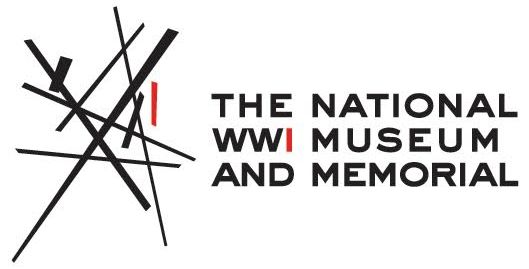
theworldwar.org/
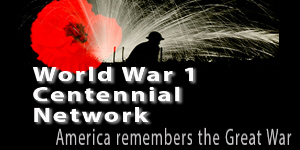
www.ww1-centennial.org/

history.army.mil/
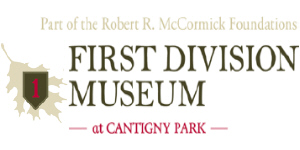
www.firstdivisionmuseum.org/

www.abmc.gov/
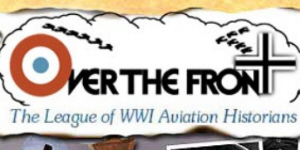
www.overthefront.com/
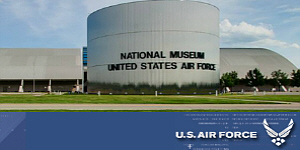
www.nationalmuseum.af.mil/

www.worldwar1.com/dbc/
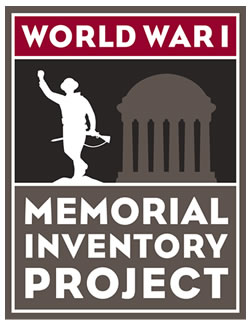
wwi-inventory.org/

wisconsinhistory.org/

www.uswarmemorials.org/
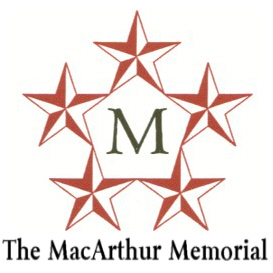
www.macarthurmemorial.org/
|
|

July Crisis of 1914
The immediate cause of the Great War was the series of diplomatic decisions and maneuvers conducted by European governments in the month following the assassination of Franz Ferdinand that are known collectively as the July Crisis of 1914. To prepare for the series of articles I'm presenting in all my publication this month, the 100th anniversary of those events. I've been reviewing my own notes I've gathered over the years. Here are some comments that struck me as especially pertinent as I was pulling various books off my shelf.
The tragedy of political decisions derives from the fact that again and again politicians find themselves in situations in which they are constrained to act in ignorance of the consequences and without being able to assess calmly the probable results, the profit or loss which action may bring. . . Men are not motivated by a clear view of their own interests; their minds are filled with the cloudy residues of discarded beliefs; their motives are not always clear even to themselves.James Joll, The Origins of the First World War
Well-Written Short
Work with Tons of
Interesting Details
|
|
. . .[He goes too far in suggesting that political leaders were fully aware of the consequences of all their actions. None of the leading European statesmen either wanted or expected that the July Crisis would lead to a world war involving all of the great powers. Each preferred a negotiated settlement to avoid a world war, and none expected at the time of the assassination that the conflict would escalate all the war to a world war.Jack S. Levy, Letter, International Security, Summer, 1991
Last, I think there is one nation whose role in the July Crisis is understated in the recent flood of books on the outbreak of the war — Russia. (Prof. McMeekin's work on the Russian origins of the war excepted.) Here's a comment about Russia's creeping mobilization.
The Russians [now] felt they must act, not simply protest, and it was they who began the militarization of the July Crisis. Yet all the Powers understood that military precautions [e.g. partial mobilization initiated 26 July] could be misinterpreted as signalling an intention to fight. Even after the delivery of the ultimatum [to Serbia] Germany and Austria-Hungary did little to raise their preparedness, hoping this would help them contain the conflict. . . The Russian measures dramatically accelerated the tempo of the crisis and wrecked their antagonists' localization strategy.David Stevenson, The Outbreak of the First World War.
|
|

Special Announcement for Our Remaining 2014 Tour:
Because of the extraordinary interest in this trip we have added a larger and more comfortable bus (a 32-seater) for Miracle of the Marne in-depth look at the most important single battle of the war. The tour is scheduled to begin 30 August, so please contact us very soon if you would like to join us.
We Are Now Accepting Bookings for Our 2015 Centennial Tours:
Gallipoli and the Dardanelles Tours
100th Anniversary of Gallipoli Tour during the Anzac Day celebrations to be conducted in collaboration with Mat McLachlan Battlefield Tours of Australia.
Western Front Tours
2-10 May 2015: I will lead this tour and cover the 1914 and 1915 Battles North of Paris, including: the Aisne & the Race to the Sea, the Siege of Antwerp, the First and Second Battles of Ypres, the Christmas Truce, and the French and British Battles in Artois.
15-23 August: My summer centennial expedition will cover the Western Front Battles of 1914 and 1915 East of Paris in the Chemin des Dames, Champagne, Argonne, and St. Mihiel sectors, PLUS the American Battlefields of 1918 at Château-Thierry, Blanc Mont, St. Mihiel, and the Meuse-Argonne.

Click on Image to Send Email
|
|
|

|

The French Hotchkiss Model 1914 Heavy Machine Gun
|
The Hotchkiss Model 1914 was the standard French Army heavy machine gun during World War I. Heavy but rugged and dependable, the Hotchkiss Model 1914 saw continuous service along the entire line of the Western Front for the full duration of the war. The gun and mount weighed 88 pounds, fired 8mm Lebel Mle 1886 rounds from a 30-round metal strip, and had a rate of fire of 600 rounds per minute. It was gas operated and air cooled, and had a maximum effective range of 3800 meters. The Hotchkiss served in both ground combat support and antiaircraft roles.
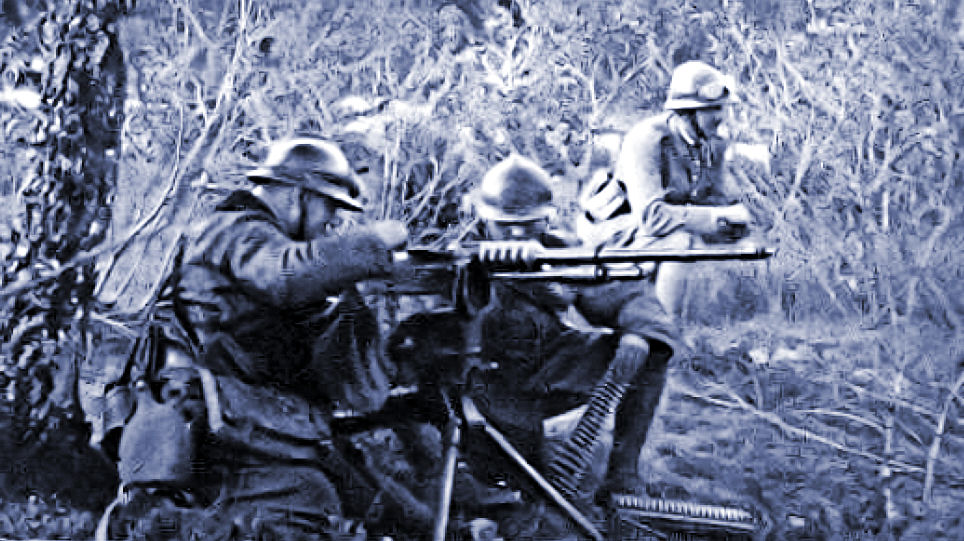
Many machine gun units of the AEF entered combat with the 1914 model of the French-made Hotchkiss machine gun. Machine guns were used by the Yanks for both indirect and direct fire missions. When in the former role, the guns were placed to cooperate with the field artillery units in neutralizing suspected enemy observation posts and machine guns during the attack and to sweep the approaches for possible enemy counterattacks after the capture of the final objective.
|
|
|

The Battle of the Ardennes, 22 August 1914
Plan XVII's Strategic Flaw
|
This past spring I led a battlefield tour of the sites of the opening actions of the Great War in the west. It included my first visit to the multiple battlefields of the Ardennes, where the fighting came to a head on 22 August 1914. On that day, inclusive of other fighting along the frontiers, the French Army suffered its greatest single day's loss of the war and Joffre's Plan XVII was utterly shattered. The full scope of the French disaster that day hit me for the first time during this visit. Going from hot spot to hot spot, I began to see a pattern, a sameness, to almost all the French defeats. At a tactical level, the German Army was simply better in the conditions of that day as both armies were advancing with aggressive intentions, but with the movements and mass of the enemy forces not fully known. In most situations, the Kaiser's forces exhibited better reconnaissance, more agility in adapting to local terrain in the variety of surprise encounters, and a vastly superior ability to deploy and focus their artillery.
Even if the French operational skills were equal to their enemy's that day, however, I saw that there was an even greater handicap for the French forces in the Ardennes. They were saddled with a fatally flawed deployment plan. The maps and charts below should help to demonstrate this.
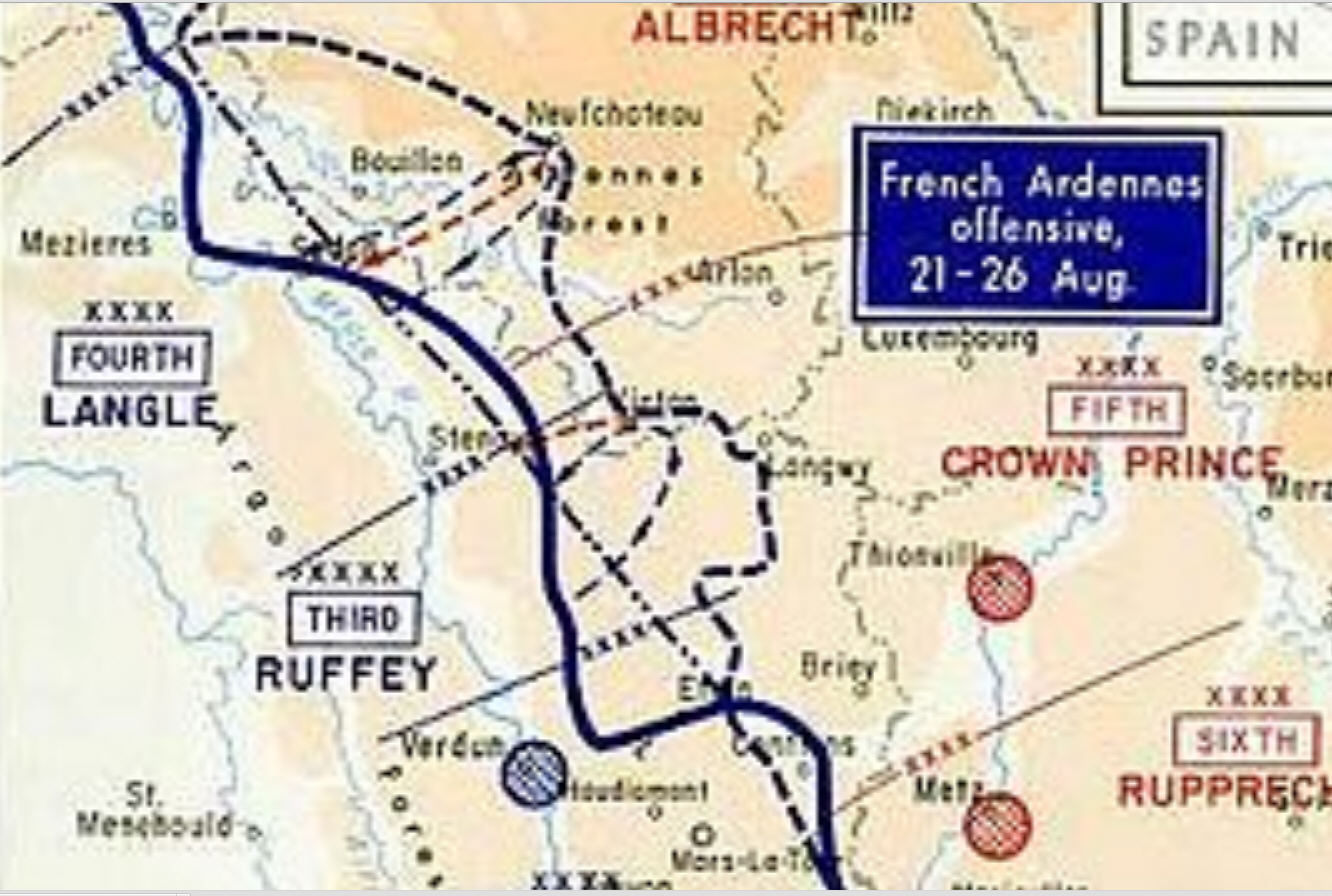
Above is the Ardennes section of a larger map that shows the Battles of the Frontiers. The Ardennes was just one of the areas of fighting on these days. The struggle in the Ardennes was the largest and most critical of these battles, involving concurrent offensives by two full armies from each belligerent, roughly facing off against one another along a 50-mile front. This map however, though geographically accurate, is misleading in a dynamic sense.
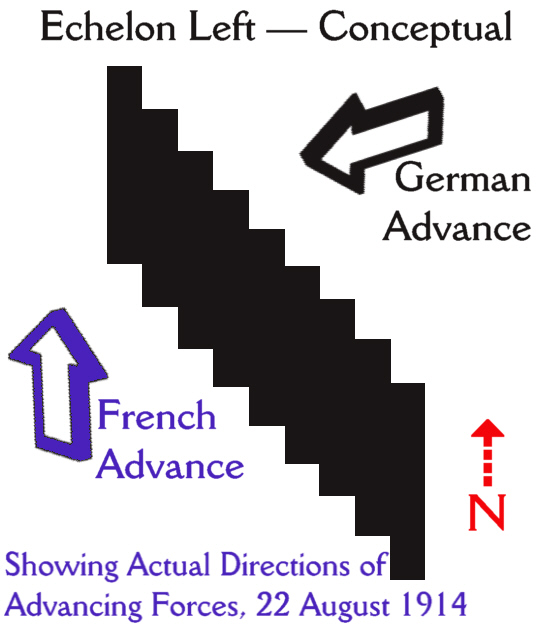
This schematic shows the actual directions of both offensives that day with the black bars indicating the relative positions of the nine Corps of the two French armies attacking that day. They were arrayed in a formation known as "Echelon Left." In some fit of geometric obsessiveness, the divisions within each corps were similarly staggered, and within each division, the brigades were also offset with the units to right about a half-day's march behind the unit on its left.
Closing one's eyes for a moment to the German movements that day, one can still imagine some problems in the offing. Advancing with an open right flank through unfamiliar country is chancy at best. Then, what happens when the unit in advance runs into a substantial enemy unit straight ahead? Does the French commander maneuver by himself, or call for help from the unit to his left — which may be having its own problems or be successfully advancing and moving ahead, beyond summoning range, or wait that half-day until he gets support on the right? By the way, about those forces on the right — suppose they, too, are blocked and fighting for their lives. They are never going to arrive in time to support the chaps on their left.
All these issues could be serious problems with the echelon left scheme, if the opposing forces were approaching each other straight on. But on 22 August 1914 the great encircling movement of the Schlieffen Plan was being executed and the German forces were pivoting and coming from the very worst direction for the French — right toward those open right flanks. Many French units suffered from some of the flaws in this deployment plan that day. But on the roads around Bertrix and Ochamps, Belgium, the 33rd Division of Infantry (DI) of XVII Army Corps (CA) experienced all of them. Their defeat provides a case study, I believe, on why the French failure this day was total and probably inevitable given the tactical competence of their opposition.
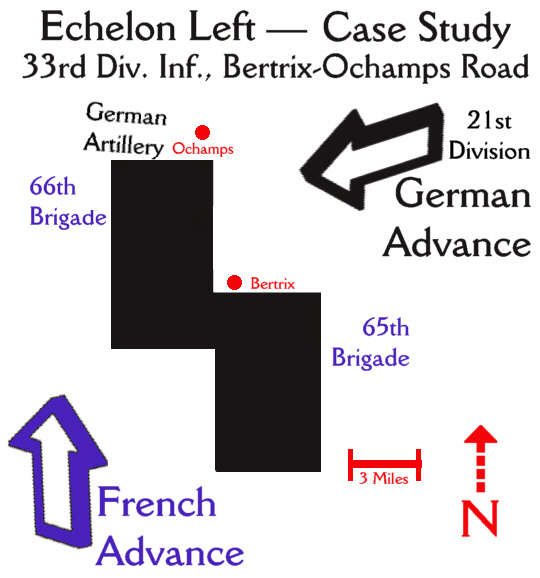
The first failure that day was due to the lack of reconnaissance. French cavalry, controlled by the Corps, failed to notice both that several batteries of enemy artillery had been deployed ahead in the village of Ochamps and that a German division was heading their way from the northeast. As the 66th Brigade of the the 33rd DI was advancing on Ochamps from the south, the divisional artillery, protected by a regiment of infantry, was traveling down the main road into Ochamps in a forested area when the German batteries in the village opened fire. The French 75s were unable to advance, deploy in the woods, or return fire.
Subsequently, just after the brigade's infantry had failed in a first attempt to take Ochamps from the flank, disaster struck. The previously undetected German 21st Division arrived on the scene. Its officers quickly saw that a ridge running roughly North to South from Ochamps to Bertrix with a second road along its crest dominated the French position. They quickly deployed artillery and machine guns along its length. Though the Germans themselves, being exposed on the ridge, suffered heavy losses, their fire annihilated almost all the French artillery and much of the infantry. Further, as the 33rd DI's other brigade finally began to arrive at Bertrix, the German forces simply turned their guns and began similarly devastating fire on the new arrivals. It was a total defeat for the 33rd DI. Its parent command, the XVII CA — with its second division, the 34th DI, now in peril — soon ordered retreat. The hasty withdrawal left a huge gap in the French position, which, fortunately for them, the Germans were not able to fully exploit.
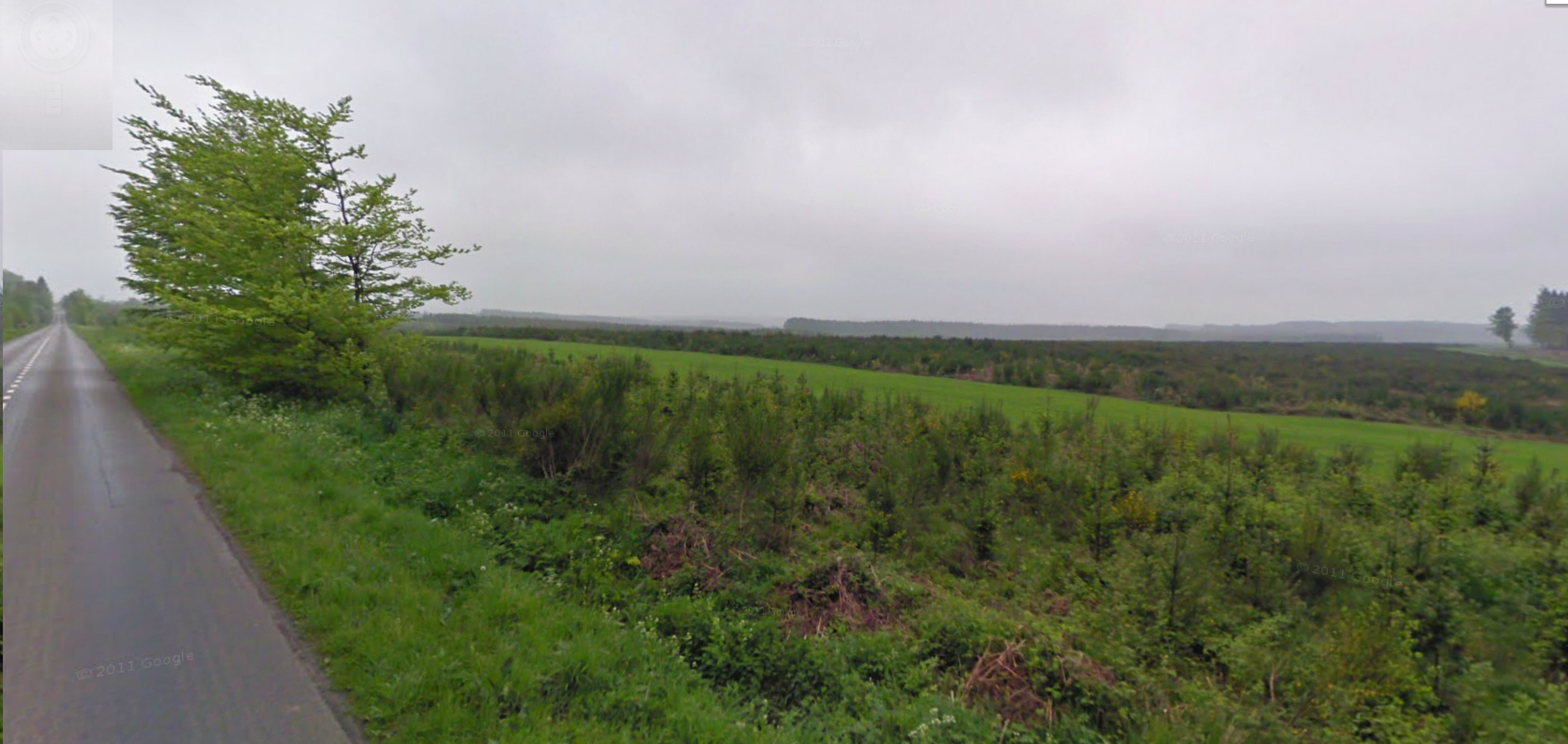
This is a photo of the open right flank of 33rd DI. Ahead on this road is Ochamps. The German artillery in the village halted any further advance down the road, trapping all the French artillery in its forested section, which is just behind our photographer. Subsequently, the German 21st Division deployed along the ridge line visible in the distance. From there it was able to inflict devastating fire on the 66th Brigade, and later to do the same to the division's sister brigade coming up from the south.
After my visit to the Ardennes and reading what I could find about the fighting there. I have concluded that action on the Bertrix-Ochamps road was a microcosm of the whole French disaster in the Ardennes. All the vulnerabililties of the echelon left deployment were exposed here and the pattern of superior reconnaissance, greater tactical agility, and effective use of artillery by the Germans played a factor as well. No wonder it was a greater disaster than the first day on the Somme.
In future issues of the Trip-Wire, we will be drawing on two more issues raised by our visit to the battlefields of early 1914: 1.) After what happened in 1914, how did French generals in the 1930s convince themselves that the Ardennes were impassable; and 2.) After the catastrophe of 22 August 1914, how did the French avoid a prequel to 1940 the next day? MH
|
|
|
Thanks to each and every one of you who has contributed material for this issue. Until our next issue, your editor, Mike Hanlon. |
|
 (Or send it to a friend)
(Or send it to a friend)
|
Design by Shannon Niel
Content © Michael E. Hanlon
|
|
|


















